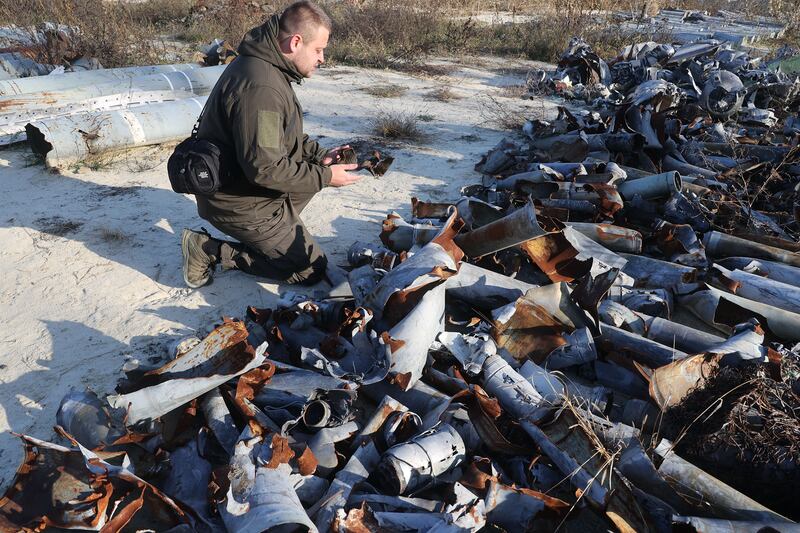Vladimir Putin’s brutal bombing campaign against Ukraine’s civilian population does not seem to be letting up. With the help of Iranian drones, relentless Russian attacks have killed scores of innocent civilians in recent months. They’ve also threatened power plants and other critical civilian infrastructure across the country, putting millions at risk of freezing this winter.
While Russia’s campaign to attack civilians with Iranian drones is well-known, new evidence shows that the drones themselves are heavily reliant on parts made by U.S. manufacturers, calling into question the effectiveness of international sanctions as well as what actions the U.S. and others can take to curb the flow of Iranian weapons into Russian hands.
A new report from Conflict Armaments Research (CAR), an organization that works with the European Union and other partners to trace international arms flows, found a shockingly high level of American and European parts in Iranian drones. CAR researchers had access to the now infamous Shahed-136 as well as a Mohajer-6, two kinds of Iranian drones used in Ukraine against military and civilian targets. Their analysis found that the drones are “almost exclusively made of components based in Asia, Europe, and the United States.”
The U.S. is last but not least on that list; a whopping 82 percent of components were made by U.S.-based companies. Of the parts where researchers could find the date of manufacture, half were from the last two years. NAKO, a Ukrainian civil society organization involved in tracing drone components and anti-corruption efforts, noted that Shahed components come from well-known companies like Texas Instruments and Panasonic.
The prevalence of parts from the U.S. and other countries made in the last few years is alarming, but U.S. or European companies don’t necessarily know if their products were going into weapons that bomb civilians. Most components listed are “dual-use,” meaning that they are not strictly for military purposes. A small engine, for instance, could power both a moped and a drone.

A wounded man, 44-years-old, Mikhail Barabash after Russia launched four missile attacks on industrial buildings of Dnipro province late at night in Ukraine on November 29, 2022.Photo by Metin Aktas/Anadolu Agency via Getty Images
Metin Aktas/Anadolu Agency via Getty ImagesThe problem is compounded when technology is sold to a middleman. In June of this year, a U.S. citizen pleaded guilty to trying to provide the Iranian government with restricted technology via a company based in the United Arab Emirates.
The revelation about U.S. and European components also sparked outrage in countries like Slovakia, where media outlets castigated the customs office for not stopping transfers to Iran, even if those components were manufactured elsewhere and simply moved through Slovakia. In Israel, journalists were also quick to interrogate Israeli manufacturers about components found in the Mohajer-6, to which they responded that it is difficult to stop online buyers from transferring components to Iran afterwards.
The U.S. and other countries have worked for years to curb the shipment of military and dual-use technologies to Iran, but the focus is rarely on drones. Preventing Iran from producing a nuclear weapon or improving their missiles took most of policymakers’ attention. UN Security Council Resolution 2231, for instance, is almost entirely about restricting the Iranian government’s access to technologies and services that could help them construct a nuclear weapon, although restrictions on long-range drones are included.
Iran is far from the only actor using U.S. and European dual-use technologies to attack civilians. Russia itself relies on foreign technologies to underpin its defense industry. Investigations into Russia’s Iskander missile revealed that it also had components from companies like Texas Instruments. Western attempts to restrict these technologies and the refusal of companies like Texas Instruments to continue selling products to Russia put the Kremlin’s defense sector under as much strain as the rest of their economy.
Some efforts to stymie Iranian transfers to Russia have been made, but they fall short of solving the problem. This month, the U.S. slapped sanctions on several Iranian entities for their involvement in the manufacture of lethal drones and their transfer to Russia. While welcome, these particular sanctions do not address the fundamental issue of how components make their way to Iranian industry in the first place.

A representative of the prosecutor's office conducts investigative actions to document material evidence of Russian aggression against Ukraine at a special site where the remains of missiles and shells used by the occupiers to attack Kharkiv are being collected, Kharkiv, northeastern Ukraine.
Vyacheslav Madiyevskyi / Ukrinform/Future Publishing via Getty ImagesCAR’s report also notes that Iran’s drones are improving thanks to smuggling and leveraging dual-use products. CAR and United Nations experts were able to look at Iranian drones in places like Yemen in the past. Compared to older types of drones, those used in Ukraine are much more sophisticated. Some of the new components, most notably the Inertial Measurement Units used to help the drone navigate midair, have been found despite being tightly restricted by the U.S. on paper.
The scope and scale of Iran’s access to Western components is appalling, but its reliance on imported components presents an opportunity. Iran invests heavily in its drone program as a means to deter its regional adversaries and empower its proxies and partners across the Middle East.
Stopping illicit transfers and the use of dual-use technologies is far less challenging than if Iran were able to manufacture all of these components itself. With external researchers like CAR and NAKO, as well as efforts from U.S. and European authorities to help companies restrict transfers to Iran-linked actors, there is a strong possibility that a lot of components will be trickier for Tehran to get in the future. Curbing Iran’s drone production will hurt their efforts to support Putin’s bombing campaign in Ukraine—and challenge their ability to do the same across the Middle East.







